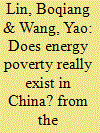| Srl | Item |
| 1 |
ID:
177482


|
|
|
|
|
| Summary/Abstract |
China is undergoing a market-oriented reform in energy and the residential sector will be involved in the near future. The analysis of energy poverty is crucial in breaking the illusion of the dilemma between enhancing energy efficiency and controlling poverty. Based on Chinese residential energy consumption survey, we firstly estimated the energy poverty in China by the “10% indicator” and “LIHC indicators”, and then proposed a “minimum end-use” method to classify the energy-poor households into lifeline and consumption energy poverty. Results show that energy poverty exists in China at the proportion of 18.9%, and 46% of the energy-poor houses are in short of modern energy consumption and are sensitive to tariffs, with a level of electricity consumption lower than the basic demand. The energy poverty rate is highest in central China, while the lifeline energy poor are relatively concentrated in the western region. In terms of public policy, we suggest focusing on heterogeneity by considering different groups of households when implementing energy efficiency measures, and targeting more on the consumption energy poor in poverty alleviation. We also suggest paying particular attention to targeting households with low income by supporting practices such as coupons for energy consumption and appliance purchasing.
|
|
|
|
|
|
|
|
|
|
|
|
|
|
|
|
| 2 |
ID:
178815


|
|
|
|
|
| Summary/Abstract |
China is undergoing an energy-market reform while the residential sector remains the most prudent for its close relationship with livelihood. Based on the Chinese household energy consumption survey, a demand function is established to estimate the determinants of residential electricity consumption. With a micro-model, the changes in welfare and redistribution under different scenarios are estimated. From the results, the current subsidy is ineffective; each high-income family receives the cross-subsidy of 35.65 CNY per month, which is 3 times of the low-income family. Price increment leads to less subsidy and deadweight loss but a loss in welfare, and the adjustment in the price on the 1st block is more conducive to the subsidy decline. With a similar overall effect, the non-uniform increase is more effective in subsidy redistribution by widening the price gradients between IBP (increasing block price) blocks and is recommended. Considering the burden of subsidy, the government and the power grid companies are suggested to clarify the pricing scheme to help the public get informed, and thereby, win the support of the public in the energy reform.
|
|
|
|
|
|
|
|
|
|
|
|
|
|
|
|